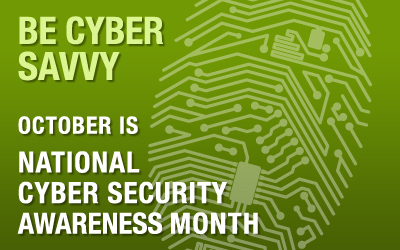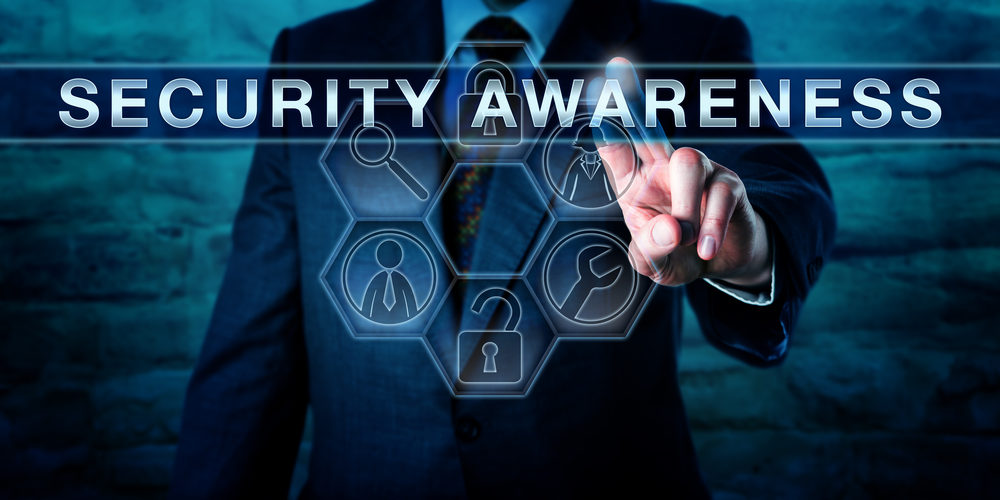A look at cyber awareness and tips for protecting yourself online
Whether you are turning on the television, checking the daily newsfeed online, or reading a magazine, you’re sure to hear about the breach of a major business such as Yahoo, a data leak by the government, or hackers attacking a local school. Over the last two decades, cybersecurity has been legislated to protect consumers, businesses, and the government alike. There’s a need for greater awareness of cyber security and how people can best protect themselves and their businesses. That is the purpose behind National Cyber Security Awareness Month (NCSAM) which has been celebrated every October for the last 15 years.
The History of NCSAM
Developed as a collaborative effort between industry and the U.S. government, the purpose of NCSAM is to ensure every American has the necessary resources to stay safer and more secure online as well as advance awareness of the threats we all face when we log on. Launched in 2003, NCSAM was conceived by the U.S. Department of Homeland Security and the National Cyber Security Alliance.
According to the National Cyber Security Alliance, the goal was to reach as many people and businesses as possible to educate them about cybersecurity. The target audience consists of consumers, small and medium-sized business, corporations, educational institutions and young people across the country.
STOP. THINK. CONNECT.
This year marks the 8th anniversary of the STOP. THINK. CONNECT.™ campaign used during NCSAM which offers tips and advice for everyone from the daily internet user to business owners.
The message to consumers of every age is clear. We are all warned to stop and think before connecting which means doing things to protect ourselves before we get online. We are warned to “Keep a Clean Machine,” “Protect Your Personal Information,” and “Connect with Care.” But what does all of this really mean?
Keep a Clean Machine
All of your internet-connected devices should be kept free of malware and other infections such as viruses as they can interrupt your connectivity at home and at work as well as spread to others. A dirty machine can also threaten your safety and the safety of others online. This is especially true when it comes to malware that connects your devices to botnets, which are networks of computers controlled by cybercriminals that can steal your information and make money from it.
There are several things you can do to keep a clean machine including:
- Use the Latest Software– Ensure you have the newest security software, web browser and operating systems to offer the best defense against known viruses, malware, and other threats.
- Automate Updates– Most software programs automatically update to defend against threats. Keep auto updates turned on and turn your computer off each night so updates will occur when you reboot.
- Protect Every Device– In addition to computers, be sure to turn on auto updates for all devices including smartphones, laptops, and tablets.
- Plug & Scan– External devices such as USBs can harbor viruses and malware. Use security to scan them before using.
- Get Rid of Garbage– Delete links, emails, tweets, posts, etc. that look suspicious. These are ways cybercriminals compromise your computer. If it’s not from a trusted source, trash it. Don’t open it.
- Hot Spot Smarts– Limit the business you conduct when away from your home or office. Be sure to adjust the security settings on your device to limit who can access it.
- Act Fast– If you think your machine is infected, get help fast to remove viruses and malware before they can spread or cause more damage.
Protect Your Personal Information
Each one of us has the responsibility of protecting our personally identifiable information (PII) online. If your personal information ends up in the wrong hands, there could be serious consequences from a breach in your social media or theft from your business to your identity being stolen and your bank account being wiped out.
While you may have worked hard to protect that information, all of us must still assume our personal information has been leaked because hacks happen all of the time. Here are some tips for protecting your PII online from the New York Times:
- Use Different Passwords– Across multiple sites from Facebook to your bank account, NEVER use the same password in more than one place. Doing this allows a hacker that gets your password in one place to use it in another. Password managers such as 1Password or LastPass can help you keep track of them all.
- Never Your Social- Never use your social security number as a username or password. This is especially true in the face of the recent Equifax breach.
- Be Suspicious- Treat everything online with an abundance of suspicion. Hackers send emails, notices, letters, etc. posing as people you know and businesses you solicit to gain information. Contact a business or individual requesting PII online by calling them directly before deleting the email as they may need it to press charges or stop the cybercriminal from targeting others.
- Use Stronger Passwords- Sites such as LastPass can help you create unique passwords for each site you visit and save them for you in a protected database. If you create your own, be sure to use uppercase and lowercase letters, numerals, and special characters in each password.
- Employ Extra Security- Passwords are not enough. If a site allows you to use secondary or two-factor authentication, enable those features. When you enter your password, you will receive a message with a one-time login code to allow you to finish logging in.
Connect with Care
Many web users are very quick to click whether it be on an email, a link, or an attachment. Slow down and take time to examine what it is you are about to click before you do so. Ensure you know who an email is from before opening it. If you don’t know the sender or aren’t expecting an email, delete it without opening it.
If you receive an email from a person or business you know and the email address looks familiar, feel free to open it. Once open, look at the email itself. Does it sound like it’s from the sender or does it seem odd? If the English is suddenly broken, the business logo is not right or is missing, or something else is off about the email, do not click on any links or attachments. Contact the person or business directly to see if they have sent you something via email.
Use care when connecting to public Wi-Fi. This is especially true if you are conducting business such as banking or shopping online. Use only trusted secure connections when using portable devices outside of the home or office.
Be Web Wise
Personal information about anyone is now easy to find online. This is especially true with the advent and use of social media. That means we all have to be wise when it comes to using the web. The first thing you should know is how your information gets online. Here are some ways you may inadvertently be sharing your personal information:
- Posting on social media
- “Checking in” through social location sites such as Foursquare
- Commenting on blogs or shopping sites
- Creating online wish lists online at sites like Amazon or Pinterest
- Sharing videos or photos online
- Using online games
- Giving location data when uploading photos online
If you are on social media, check to see if you can change your privacy settings to limit what others can see about you or who has access to your information. Be sure to read the privacy policy of any company before sharing your information with them to ensure they don’t sell it to third parties. You’ll also want to ensure that your data is backed up at home and at the office in the event of ransomware, other cyber attacks, or even a computer shutdown.
Be a Good Online Citizen
Being a good online citizen involves employing the Golden Rule of treating others online the way you would like to be treated and using common sense. Don’t visit unsecured sites and don’t forward emails from unknown sources to others.
Be aware of how the action of one person can damage an entire online community. For example, one employee surfing unsecured sites through your business network can open the door for malware, viruses, and cybercriminals. Have common expectations in your home and office about what is an acceptable use of the network and what types of sites should be avoided.
Report cybercrime and breaches immediately. These should be reported not only to your internal technology personnel but to law enforcement as well. By reporting such issues, you are helping others avoid becoming victims, too, and stopping cybercriminals in their tracks.
Own Your Online Presence
This means safeguarding your own personal information and activity. For example, data should be treated like money. It should be protected. This means everything from your birthdate and personal address to the names of your children and pets which are often used as passwords. It can be easy for a hacker to get into your accounts with such personal information floating around on the web.
Be careful about who you share information with. For example, you may get “friend” requests from people you don’t know on social media. Simply delete the request. This is not being rude, it’s being prudent. Also, don’t send login information via email. Email can easily be hacked without the proper, updated security in place. If you get a request for information from a business online, call them to see if the request was really from them and provide any data they may need that way.
Lock Down Your Login
One of the main points of the STOP. THINK. CONNECT.™ campaign is to Lock Down Your Login. There are several ways you can ensure your login information stays secure. Here are six tips to get you there:
- Protect accounts with strong authentication
- Keep security software updated
- Avoid phishing by thinking before clicking
- Use unique passwords for every site
- Protect your mobile devices
- Employ trusted security tools
Our Responsibility
Staying safe online and protecting those we are connected with is everyone’s responsibility. Because the world has become so digital, we are more interconnected than ever before. From our desktops to our tablets, phones to laptops, we find ourselves working, playing, learning, and living online. That means all of us has a responsibility to try to stay as safe as possible by adhering to the advice of cyber experts.
National Cyber Security Awareness Month is a chance for us all to become more aware of the threats we face online and ways to protect ourselves and others. For more information, safety tips, and ways to get involved in NCSAM, visit the National Cyber Security Alliance online or contact Oram at (617) 933-5060.


